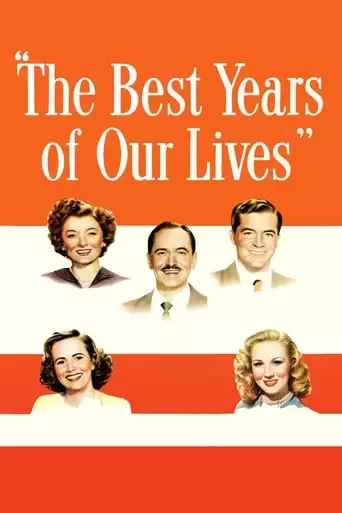It’s the hope that sustains the spirit of every GI: the dream of the day when he will finally return home. For three WWII veterans, the day has arrived. But for each man, the dream is about to become a nightmare.
The Best Years of Our Lives (1946), directed by William Wyler, is a poignant drama that delves into the lives of three World War II veterans returning to their small-town American homes. The film follows Fred Derry (Dana Andrews), a decorated bombardier; Al Stephenson (Fredric March), a bank loan officer; and Homer Parrish (Harold Russell), a sailor who lost both hands in the war. Each man faces unique challenges as they attempt to reintegrate into civilian life, confronting issues such as unemployment, societal expectations, and personal relationships.
Fred struggles with finding stable employment and reconnecting with his wife, who has become accustomed to independence during his absence. Al, a successful banker, grapples with the realization that his wartime experiences have altered his values, leading him to question his role in the corporate world. Homer’s return is marked by his physical disabilities, which he conceals from his fiancée, fearing her reaction. The narrative intricately weaves their personal stories, highlighting the broader societal challenges faced by returning veterans.
Main Themes
- Post-War Reintegration
The film poignantly portrays the difficulties veterans encounter when transitioning back to civilian life, emphasizing the psychological and social hurdles they face. It sheds light on the often-overlooked struggles of reintegration, offering a realistic depiction of the challenges veterans endure.
- Social and Economic Challenges
The Best Years of Our Lives explores the economic hardships and societal adjustments that returning soldiers must navigate, including unemployment and the shift from military to civilian roles. The film critiques the societal structures that fail to adequately support veterans, highlighting the need for systemic change.
- Personal Transformation and Identity
The narrative delves into the personal transformations of the characters, focusing on how their identities are reshaped by their wartime experiences and the challenges of returning home. It examines themes of self-discovery and the quest for meaning in a post-war world.
- Family Dynamics and Relationships
The film examines the impact of war on family relationships, highlighting the strains and adjustments required as veterans return home. It portrays the complexities of reestablishing familial bonds and the emotional challenges that accompany reintegration.
- The American Dream and Its Discontents
Through its characters’ struggles, the film critiques the notion of the American Dream, revealing the disparities between idealized aspirations and the harsh realities faced by many, especially veterans. It questions the attainability of the American Dream for all citizens, particularly those who have served in war.
Impact of the Movie
Upon its release, The Best Years of Our Lives received critical acclaim for its honest portrayal of veterans’ experiences and won seven Academy Awards, including Best Picture, Best Director, and Best Actor for Fredric March. The film resonated deeply with audiences and critics alike, offering a realistic depiction of the challenges faced by returning soldiers. Its impact extended beyond cinema, influencing public discourse on veterans’ affairs and contributing to a broader understanding of the psychological and social challenges of war.
7 Reasons to Watch The Best Years of Our Lives (1946)
- Authentic Depiction of Veterans’ Experiences
The film offers a raw and unfiltered look into the lives of returning soldiers, providing insight into the psychological and social challenges they face. Its realistic portrayal fosters empathy and understanding of the veteran experience.
- Outstanding Performances
The cast delivers compelling performances, with Fredric March’s portrayal of Al Stephenson earning him an Academy Award for Best Actor. The nuanced characterizations bring depth and authenticity to the narrative.
- Timeless Relevance
Despite being set in the post-World War II era, the film’s themes of reintegration and societal challenges remain pertinent, offering insights into the enduring struggles of veterans. Its universal themes continue to resonate with contemporary audiences.
- Masterful Direction
William Wyler’s direction ensures a cohesive and emotionally resonant narrative, skillfully balancing personal stories with broader social commentary. His attention to detail and character development enhances the film’s impact.
- Cinematic Excellence
The film’s cinematography and production design effectively capture the era’s atmosphere, immersing viewers in the post-war setting. The visual storytelling complements the narrative, enhancing the overall viewing experience.
- Emotional Depth
The film delves into complex emotional territories, exploring themes of loss, adaptation, and resilience, which can evoke a profound emotional response from viewers. Its exploration of human emotions is both poignant and thought-provoking.
- Cultural Significance
As a significant work in American cinema, the film offers historical context and cultural insights into the post-war era, enriching viewers’ understanding of the period. Its cultural impact extends beyond entertainment, serving as a historical document of its time.
How Will You Feel After Watching The Best Years of Our Lives (1946) ?
After viewing The Best Years of Our Lives, you may experience a deep sense of empathy and reflection on the complexities of post-war life. The film’s honest portrayal of veterans’ struggles and personal transformations can evoke a range of emotions, from sorrow to hope. Its exploration of human resilience and the challenges of reintegration may leave you contemplating the broader societal issues it addresses.

